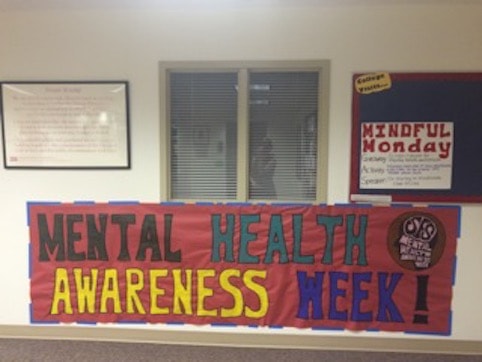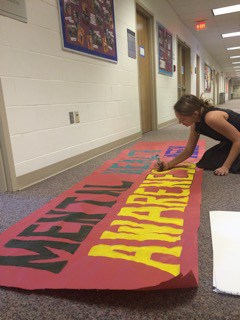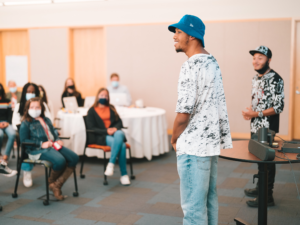Culminating Passions: Student Leadership for School-Wide Change

Molly Irvin
Have you ever broken a bone? Would you feel comfortable telling everyone how you broke that bone?
If you have broken a bone, I’m guessing this is along the lines of what happened: You felt pain. You saw that your, say, arm was clearly broken, and you probably cried. You went to the doctor and got diagnosed with a broken arm. He suggested a cast and prescribed medication for the pain. Then after you got your cast taken off you had to do some rehabilitation exercises to re-strengthen your arm.
I couldn’t ask you if you have ever suffered with mental illness. It would be unacceptable. It’s too personal. It might be embarrassing. Not my business.
Why is that? According to statistics, there would be actually be more teenagers who have suffered some form of mental illness than broken bones—at least 1 in 4. So why can’t I ask that question?
That’s a question I plan to answer. My interest in a career in psychology began when I started high school. To educate myself, I started reading all the psychology books I could get my hands on, from novels to college textbooks. I joined the American Psychological Association and took an Introduction to Clinical Psychology course in which I researched the impact of anxiety disorders on educational attainment. I also worked as a research assistant in a psychology lab at Stanford, getting exposure to the research aspect of the field. I started doing research in my school, and was invited to present my findings to educators from all over the nation at the Ideas in Education Festival.
More well-equipped, I began to think of solutions to address the lack of knowledge and awareness in my school, and diminish the social stigma around talking about and seeking treatment for mental illness. I wrote proposal after proposal, but they were all denied by the administration. Finally, I thought of Mental Health Awareness Week. My guidance counselor and I chose the week of November 9th-13th because it is National School Psychology Week. As we began to plan the week, I still didn’t know what to include, which problems were the most important to address. I needed data.
Working with the guidance counselor, I created and administered a survey to the entire student body. The results reinforced my hypothesis—there was a glaring lack of knowledge about mental health issues and mental illness among my peers. I also asked students why they think that other teenagers are unlikely to seek help if they are suffering from mental health disorders. Two-thirds think that seeming weak is a big factor. The same proportion thinks that students feel that they can handle things on their own. And 83% believe that negative social stigma is to blame. Do a lot of people think they can handle broken bones on their own? That people would think they were weak if they wore a cast? There’s certainty no negative social stigma there.
The students’ responses to the survey were the last piece of information that we needed for Mental Health Awareness Week. When we asked students how to combat the stigma, almost all of them had ideas. The four most common responses were: educating people about mental health and mental illness; talking openly and often about it; creating a supportive, accepting environment in which people feel safe enough to ask for help; and making sure that people know that mental health problems are normal, common, and treatable, just like physical health problems. These responses informed the planning for the entire week.
Armed with this data, I planned a full slate of activities for Mental Health Awareness Week to provide students with information they lack and make them more comfortable talking about mental illness. I developed a theme for every day, invited mental health professionals to speak and facilitate discussion, designed beautiful and informative posters to hang around the school, and planned interactive activities to inspire students to participate. My greatest hopes were that those who have been suffering in silence can seek help, and that all students can learn enough to be able to help others.
The week was designed for students who are struggling with something and want to learn more about it or about how to get help, who know someone else who is struggling and want to learn more to be able to support them, who just want to learn more because they understand how big of a problem this is and want to be part of the solution, or who might be interested in studying psychology and have never had a chance to start because their school doesn’t offer any classes. Students were encouraged to listen to the speakers, think about their mental health and that of others, and talk about what they learn.
I think we all know that high school can be a very stressful and anxiety-inducing place. With this week, I encouraged my school community to take one big step towards making our school a leader in awareness and action, not a leader in stress.
I have known for a while now that I want a career in clinical and researching psychology. And even though it’s been challenging to pursue this passion in high school, I have tried really hard to get started. With Mental Health Awareness Week, I feel like I’ve taken a huge step. My advice to other high schoolers: as soon as you find that passion, start small, set a goal, and stay determined until you really make a difference.
About “GenDIY”
Young people are taking control of their own pathway to careers, college and contribution. Powered by digital learning, “GenDIY” is combatting unemployment and the rising costs of earning a degree by seeking alternative pathways to find or create jobs they love. Follow their stories here and on Twitter at #GenDIY. For more, check out:
- Getting Smart Podcast | GenDIY: Emerging Options for Students Navigating Life
- Design Thinking for Student Ownership of Learning
Molly Irvin is a student at Sidwell Friends School in Washington D.C.







stanley walker
very impressive presentation and a commitment to make a difference now and in the future
sharon sanderson
I was very impressed with the research and planning of the program you are bringing to teenagers. I wish you much success in this endeavor. Hopefully you will continue your interest in the field of mental illness and will pursue a career in this area. You should be very proud of your work. I have no doubt your family is proud of you too.
Sharon Sanderson
Joan B. Gewurz
This article addresses a very important issue. The issue of adolescent mental health is often not discussed because of the stigma attached to this topic. When a teenager feels comfortable seeking assistance in this area they will be able to avoid more serious problems as adults. Also, as the author of this article points out young people are more successful academically and socially when they are able to receive services for a mental health issue.
Molly Irvin and her school Guidance Counselor deserve accolades for a well planned project which spearheaded a program of awareness and student involvement of this very important subject with the students at their school.
Marjorie Seger
Such an enlightening and very sensitive article. So informative!!!